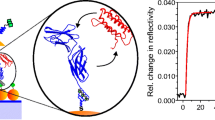Abstract
Self-assembled gold monolayers offer several advantages for the realization of novel modified electrodes for biosensor applications. This is due to their ability to decrease non-specific adsorption and provide for covalent attachment of biomolecules. Surfaces for these applications require the precise control of ligand density, the ability to immobilize ligands, and in situ-modulation of ligand activity. In this study, we focused our studies on the immobilization of antibody on a gold monolayer surface. We self-assembled thioctic acid onto the gold surface as an anchor point for the immobilization of anti-fibrinogen onto the surface. The modifications to the gold surface were characterized by ELISA, ellipsometry, and AFM.
Similar content being viewed by others
References
T Wink, SJ van Zuilen, A Bult, et al., Self-assembled monolayers for biosensors, Analyst, 122, 43R (1997).
BA Snopok, KV Kostyukevych, OV Rengevych, et al., A biosensor approach to probe the structure and function of the adsorbed proteins: fibrinogen at the gold surface, Semicond Phys Quantum Electron Optoelectron, 1(1), 121 (1998).
J. Lahann, S Mitragotri, TN Tran, et al., A reversibly switching surface, Science, 299, 371 (2003).
YS Shon, R Colorado, CT Williams, et al., Low density selfassembled monolayers derived from 2-Monoalkyl-propane-1,3-dithiols, Langmuir, 16, 541 (2000).
MJ Ford, C Masens, MB Cortie, The application of gold surfaces and particles in nanotechnology, Surf Rev Lett, 13, 297 (2006).
LT Banner, A Richter, E Pinkhassik, Pinhole-free largegrained atomically smooth Au(111) substrates prepared by flame annealed template stripping, Surf Interface Anal, 41, 49 (2009).
JC Love, LA Estroff, JK Kriebel, et al., Self-assembled monolayers of thiolates on metals as a form of nanotechnology, Chem Rev, 105, 1103 (2005).
K Wadu-Mesthrige, NA Amro, G Liu, Immobilization of proteins on self-assembled monolayers, Scanning, 22, 380 (2000).
B Lee, S Park, K Lee, et al., Selective immobilization of biomolecules onto an activated polymeric adlayer, Biointerphases, 2, 136 (2007).
D Kim, D Kang, Molecular recognition and specific interactions for biosensing applications, Sensors, 8, 6605 (2008).
I Park, N Kim, Thiolated salmonella antibody immobilization onto the gold surface of piezoelectric quartz crystal, Biosens Bioelectron, 13, 1091 (1998)
SK Vashist, R Raiteri, R Tewari, et al., Quantification of human immunoglobulin G immobilized on gold-coated silicon chip for biosensing applications, J Phys: Conf Ser, 34, 806 (2006).
C Yam, M Deluge, D Tang, et al., Preparation, characterization, resistance to protein adsorption, and specific avidin-biotin binding of poly(amidoamine) dendrimers functionalized with oligo(ethylene glycol) on gold, J Colloid Interface Sci, 296, 118 (2006).
JK Lee, Y Kim, Y Chi, et al., Grafting nitrilotriacetic groups onto carboxylic acid-terminated self-assembled monolayers on gold surfaces for immobilization of histidine-tagged proteins, J Phys Chem B, 108, 7665 (2004).
W Lee, B Oh, W Lee, et al., Immobilization of antibody fragment for immunosensor application based on surface plasmon resonance, Colloids Surf B Biointerfaces, 40, 143 (2005).
S Choi, J Chae, Methods of reducing non-specificadsorption in microfluidic biosensors, J Micromech Microeng, 20, 1 (2010).
GD Lowe, A Rumley, IJ Makie, Plasma fibrinogen, Ann Clin Biochem, 41, 430 (2004).
Z Yang, D Zhou, Development of a biosensor for measuring plasma fibrinogen based on an enzyme kinetic model, Biotechnol Lett, 27 (21), 1689 (2005).
E Briand, M Salmain, J Herry, et al., Building of an immunosensor: how can the composition and structure of the thiol attachment layer affect the immunosensor efficiency?, Biosens Bioelectron, 22, 440 (2006).
M Arruebo, M Valladares, A Gonzalez-Fernandez, Antibodyconjugated nanoparticles for biomedical applications, J Nano Mat, 2009, 1 (2009).
N Backmann, C Zahnd, F Huber, et al., A label-free immunosensor array using single-chain antibody fragments, PNAS, 102, 14587 (2005).
T Ibii, M Kaieda, S Hatakeyama, et al., Direct immobilization of gold-binding antibody fragments for immunosensor applications, Anal Chem, 82, 4229 (2010).
Author information
Authors and Affiliations
Corresponding authors
Rights and permissions
About this article
Cite this article
Cho, H., Zook, J., Banner, T. et al. Immobilization of fibrinogen antibody on self-assembled gold monolayers for immunosensor applications. Tissue Eng Regen Med 11, 10–15 (2014). https://doi.org/10.1007/s13770-013-1119-4
Received:
Revised:
Accepted:
Published:
Issue Date:
DOI: https://doi.org/10.1007/s13770-013-1119-4




